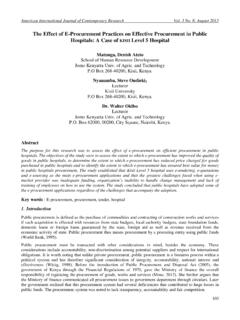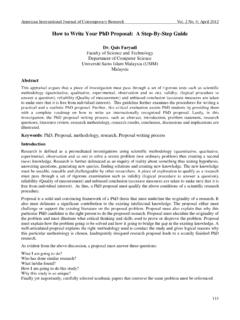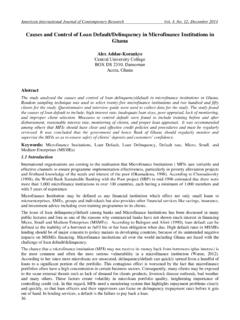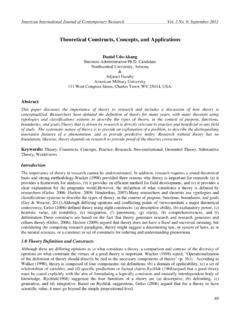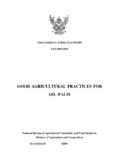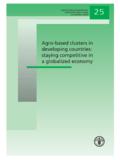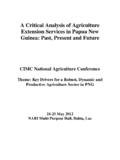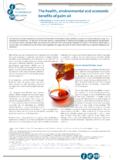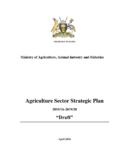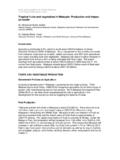Transcription of Methods of Palm Oil Processing in Ogun state, Nigeria: A ...
1 American International Journal of Contemporary Research Vol. 4, No. 8; August 2014 173 Methods of Palm Oil Processing in ogun state, Nigeria: A Resource Use Efficiency Assessment Adeniyi O. R. Ogunsola Oluwusi D. Department of Agricultural Economics Bowen University, Iwo, Osun State Nigeria [ Abstract Data for this study were obtained with the aid of structured questionnaire. A total of 70 questionnaires were administered to the palm oil farmers/ producers with the response rate of %. The data were analysed by the use of descriptive statistics, multiple regression and costs and returns tools.]
2 The results obtained revealed that although mechanized palm oil processors were not fully economically efficient in the use of resources, mechanized palm oil Processing was still more profitable relatively. Palm oil processors should therefore adopt good management strategies and practices in order to ensure efficient utilization of existing and available resources. Keywords: Palm Oil, Resource use, Efficiency Introduction Palm produce accounted for about % of the Nigeria s total domestic export between 1966 and 1973 (Usoro, 1974) and about 22 % of the foreign exchange earnings up to the beginning of the civil war (Modebe, 1978). As at 1986, the Nigeria s domestic palm oil production was estimated to be 760,000 metric tonnes while her imports then stood at 179,000 metric tonnes. Palm kernel, a by-product of palm oil is also consequently produced in large quantities in Nigeria during the same period.
3 Palm kernel output however declined from 419,000 metric tonnes during the period 1960 1965 to 385,000 metric tonnes from 1985 1987 probably due to poor market outlet for the product. The oil palm is one of the important economic crops in the tropics (Anyawu et al., 1982). It is the most important source of oil and produces more oil per hectare than any of the oil producing crops. The primary products of the oil palm are palm oil (from the mesocarp) and palm kernel oil obtained from the kernels (seeds). Palm oil contains carotene, a precursor of vitamin A, a high prized energy vitamin rich food used for cooking in oil producing countries of Africa. Palm oil and palm kernel oil provide raw materials in the manufacture of soaps and detergents, margarine, candle, confectionery, epoxy resins, bakery trade, lubricants, pomades and cosmetics.
4 Other uses include palm kernel cake obtained from the crushing of palm kernel to extract oil. It serves as additives in livestock feed manufacture. Palm wine which is obtained from the male inflorescence is very popular and of great socio-economic importance in some parts of Nigeria. The trade in palm wine competes favourably with that of palm oil. There is no part of oil palm that is not of economic value. The leaflets are used for making thatch for roofing houses while the leaf rachises are used for fencing, reinforcing buildings and basket making. The midribs of the leaflets are used for brooms. The palm cabbage, a soft tissue and the apical bud serves as a delicacy for eating. The bunch refuse, which is left after the fruits have been removed from the palm bunch, is a rich source of potassium.
5 Locally, it is used for making soap. The fibre residue left after the oil has been extracted from the fruit provides fuel while the shell from cracked palm nuts provides not only fuel, but also serves as an aggregate for flooring houses. The palm trunk is sawn into timber and used in construction of fences, roofing houses and reinforcing buildings. Center for Promoting Ideas, USA 174 The Food and Agriculture Organization (FAO, 2002) of the United Nations compiled a bulletin describing Methods of palm oil Processing . According to the bulletin, often small-scale facilities, which process two or less tonnes of fresh fruit bunch per hour, employ batch processes that utilize manual labour and have low operating costs.
6 Large-scale facilities typically use continuous systems and require skilled labourers and greater management. Large-scale plants process more than ten and often up to sixty tonnes of fresh fruit bunches per hour (Kwaski, 2002). Palm Oil Processing Methods Manual/ Traditional Palm Oil Processing Pounding (digestion) and oil extraction are the most tedious and essential operations in traditional palm fruit Processing ; therefore, early efforts concentrated on these tasks. In small-scale Processing , digestion, that is, the breaking up of the oil-bearing cells of the palm fruits mesocarp, is the most labour intensive activity (Kwasi, 2002). Two Methods of fruit maceration are common in traditional Processing : pounding cooked/soaked fruits in large wooden or concrete mortars with a wooden pestle and foot trampling the cooked but cold fruits in canoes or specially constructed wooden troughs.
7 The general traditional method of oil extraction consists of steeping the pounded fruit mash in hot or cold water; removing fibre and nuts in small baskets and hand squeezing; filtering out residual fibre from the oil/water emulsion in perforated metal colanders or baskets; boiling and skimming palm oil from the oil/water mixture and drying the recovered oil (Poku, 1998). The village traditional method of extracting palm oil involves washing pounded fruit mash in warm water and hand squeezing to separate fibre and nuts from the oil/water mixture. A colander, basket or a vessel with fine perforated holes in the bottom is used to filter out fibre and nuts. The wet mixture is then put on the fire and brought to a vigorous boil. After about one or two hours, depending on the volume of material being boiled, the firewood is taken out and the boiled mixture is allowed to cool.
8 On cooling to about the body temperature ( ), a calabash or shallow bowl is used to skim off the palm oil. Large quantities of water is used in washing the pulp hence this procedure is called the wet method (FAO, 2002). Oil extraction processes from the palm-nut was a process that span approximately 21 days for the farm family, and it involves the cooperation of the man, his wife and children, and in some cases, members of the extended family. The first stage in palm collection was the climbing of the palm trees using ropes woven from raffia palms. The man uses a cutlass or an axe to cut down the nuts, usually bunched together in a big cob of about eighteen inches long. The wife s role was to haul to the trough the nuts collected in a single day, which amount to a little over one puncheon (13 cwt) or 180 gallons of oil and fifty-six bushels of palm kernel (Bradbury, 1957).
9 In certain circumstances, such as when the tapper is a bachelor or the husband is sympathetic if the wife is very sick, the man could assist the woman in gathering the scattered nuts to his own trough. At the end of the collecting period, the palm nut collector (Oberokpain: Isoko- Urhobo) then slices the bunches into four or more smaller pieces each, covers them with palm branches after which they are left for a period of two to three days to ferment a little. This fermentation softens the nuts and facilitates further Processing . Water is then added to the pulp and shaken vigorously to float the oil that is left in the nuts and hairy integument. The oil is siphoned off from the top of the water into drums and boiled for about one hour. The oil obtained through the traditional method of Processing is usually of poor quality; hence it may be further subjected to additional boiling to remove impurities after which it is poured into kegs of various litre sizes ready for consumption and sale.
10 Meanwhile, the clean nuts and fibrous residues are thrown out of the trough to dry for about nine to ten days. These are shared by the women who participated in the palm oil Processing . The women crack the nuts to recover the seeds for domestic use and for sale (Mba, 1982). Mechanized/Modern Palm Oil Processing The process of producing crude palm oil requires a large set of equipment, which can range from crude, manual mechanisms to advanced automated machinery. Regardless of the types of machines used to produce crude palm oil, there are still a set of basic steps needed to produce palm oil. The first step in palm oil production is harvesting the palm fruit bunches. A harvester cuts the fresh fruit bunches from trees and allows them to fall to the ground. The fruits may be allowed to ferment, or fully ripen, in order to loosen the base of the fruit lets from the bunches and to make their removal easier.
